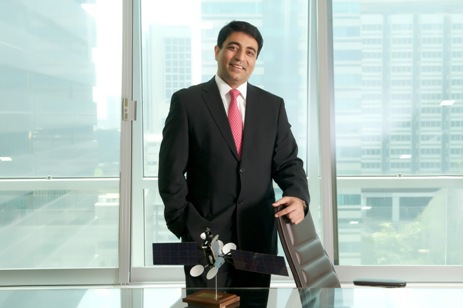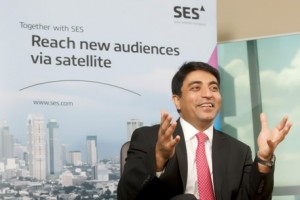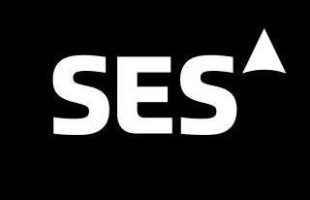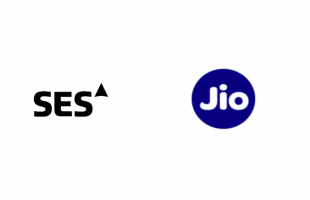
Deepak Mathur, Senior Vice President, Commercial, Asia Pacific and the Middle East, SES
Q: Would SAT-IP be considered a sort of OTT? Is there a possibility that it can bypass the pay-TV operators and operate on its own?
A: If we would take a step back and look at OTT today, I think it contains three key elements. One is the notion of multi-screen TV which is being able to watch a subscription on multiple devices. The second is legal OTT, such as Hulu or Netflix. They are essentially an on-demand service that is typically paid for. The third is the illegal OTT component. If we were to look at each of these independently, SAT-IP effectively addresses the multi-device component of it. We see that as where OTT is probably going to head in the future because ultimately linear channel TV is going to continue to be the dominant method of delivery for TV content.
However, we fully appreciate and recognise that people are moving into multiple devices; therefore need to have access to their content on multiple devices. Next is the notion of TV anywhere; when you’re travelling, you want access to your subscriptions. If you look at the successful deployments of OTT, by that I mean a multi-screen TV anywhere; those deployments have typically been in the U.S. in the form of Dish TVs, TV anywhere, Comcast and more. Really what they are is a very important add-on or support to traditional linear TV. They are not, by any way shape or form, a replacement for traditional linear television. There are several reasons for that. One is the notion of content discovery – the ability to know what to watch. In a purely on-demand environment, it’s difficult to know what is available and what you want to watch. Two, none of the networks are capable of supporting high definition content to multiple screens in the home simultaneously in order to replace what is, today, the lean-back experience of watching television on the couch. There is a space for lean-forward, which is wanting to watch Gangnam Style on demand, but it does not by any way replace the notion of lean-back.
The economics of distributing content via the web will change overtime. Presumably, they will come down. However, the advantage of satellite and traditional forms of linear television distribution are so strong that in my view, the replacement of unicast – which is essentially what on-demand TV is – with the economy, will never be the same as broadcast which is what satellite and cable television do. We continue to believe that there is a very strong position or proposition for the distribution of linear TV, the satellite and cable, the traditional forms of distribution, but there is indeed a roll where this can be complemented by alternate forms which lead to multi device, viewership and TV anywhere viewership.
SAT-IP is designed to address very specific problems. It’s designed to address the fact that; in fact, one of the members at one of the board meetings held up a tablet and said, “Guys, there’s no satellite tuning, what are we going to do about it?” So SAT-IP was born out of that question which was to convert standard linear television, the entire bouquet that you subscribe to, to convert that into IP allowing up to eight devices to simultaneously access independent channels within the home. And we think it’s a very important element of enabling multi device viewing in the home.
Q: Would that in any way bypass the pay-TV operators? I think that was the initial fear when it came to OTT or rather streaming technologies as a form of delivery, but I think the industry now does concede that it is not as big of a threat as was initially thought out to be. So what about SAT-IP, is it complimentary?
A: I think SAT-IP sits right in the value chain as an inherent and integral part of the pay-TV offering. It will sit after the set-top box which means after subscription has been paid for and the content has been received. It is simply taking the users’ subscription which means channel 1 through 20 rather than 21 through 40. Let’s say he’s got a package from 1 through 20, the SAT-IP converter will only address the component that he is authorised to watch and that he has paid to watch. So it is really intended as a complement and not as a replacement or for any way to go around the traditional eco system that the pay-TV operators spent an enormous amount of money to build.
Q: What are your thoughts about Myanmar and Indonesia in terms of their potential for the satellite industry?
A: I think Indonesia has the potential and will have similar growth trends that we’ve seen in India for satellite services. The sector is currently dominated by two pay-TV operators. We’re seeing a lot of fragmentation beneath that. Indovision and PT Telkom are sort of major players, then there are a lot of new and emerging players. Given the size of the population, the low penetration of pay-TV, the appetite for TV consumption, the existence of a very vibrant free-to-air market, I think all the signs are there for a very robust pay-TV environment.
A lot of people have not in the past put a substantial amount of KU-band capacity into that market because it was somewhat limited or perceived to be a somewhat limited market. That’s going to change over the course of the next three to five years. There’s going to be a significant investment of satellite capacity into that market. SES in fact, has put one satellite, SES-7, which has KU-band capacity over that market; and we’ll be contemplating that with another satellite called SES-9, which will be co-located and will add a significant amount of capacity into the market. We very clearly see the potential of Indonesia to grow into a significant pay-TV market and we fully hope to participate in the growth of that market.
Now, Myanmar is a little more interesting. Indonesia has passed its inflection point; it is going to go down a very sustainable path. Myanmar is going through a process where the sanctions are still somewhat in place but are being rapidly removed. SES is looking at the market very carefully but we obviously need to comply with Europe and the U.S. sanctions. As soon as those start to unlock, we see a tremendous opportunity; initially for telecommunication services, it will follow the normal path that most developing economies have followed. Initially, the demand is more for very limited television and a significant amount of telecommunications. So the launch of a substantial widening of 2G networks in the country leap frog into 3G or potentially 4G, all of the infrastructure that goes around that as private enterprise sort of starts to move out enabling banking services, e-government services and more. I think as a subsequent step, probably three to four years out, we’re going to see the unlocking of the broadcast sector but I wouldn’t say we’re at that point as yet. I think all the signs are for the wonderful potential of that market and we’re all watching it very closely and we’re hopeful that we’ll be opening up on that market very soon.

A: SES-9 is the third satellite that we’ve announced for Asia in the last three years which just goes to show the fact that we are absolutely convinced of the promise in the growth of this market. We announced SES-7 three years ago, SES-8 which is going to be launched this year and in 2012, we announced SES-9. Quite clearly, and we’ve talked about this before, there are three or four key trends that are converging: the size of the population, the favourable GDP growth, the youth of the population across Asia and the increase of HD television. All of these are big drivers which are going to cause DTH and High-Definition television to penetrate very significantly.
If you look at SES-9, we’ve designed a satellite in extremely close cooperation with our existing customers and potential customers to make sure that the beams are designed for exactly what those customers want to them to do, which is the distribution of high powered pay-TV. At the same time we recognise, and in SES’s portfolio in Asia, there’s a very equitable mix between enterprise, and video or media services. We’ve got about 50% of our revenues come from enterprise customers, 50% from video. So we also made sure we’re building for our enterprise customers. I think it’s a very well balanced satellite, it’s been conceived and designed with our customers, and really is our attempt to make sure that we are providing sufficient capacity for the key DTH customers that we have at the 108 orbital slot to provide them with growth, to provide them with redundancy and essentially allow them to capitalise on the opportunity of the market.
Q: There’s been a lot of talk on HD content, how the demand is there. In 2012, the legislation in India has gone through quite a bit of changes, like taxation issues. Are the obstacles still there and how has it changed over the year?
A: I think one of the biggest, positive developments in India is the digitisation legislation. There is no question that we’ve had a few fits and starts in terms of the deployment but whenever you think of the size or what is trying to be accomplished; it’s inevitable that they are going to be players that favour the legacy system or those that favour the chain system. I think it’s inevitable that there is going to be digitisation; it is going to go forward and it is going to unlock, to some degree, the whole ecosystem.
At the moment probably two-thirds of the Indian pay-TV market is served by analogue cable which means there is limited opportunity for content providers to monetise their content because everything gets carried on the cable network. Once you’ve digitised it, you have the ability to offer value-added services, you have the ability to differentiate your content by offering things like HD and that’s going to be good not just for the cable sector but it is good for the whole ecosystem. It encourages the appetite for tiered services and that’s good for satellite DTH, good for cable. It’s good for the content owners and it’s finally good for the subscribers because if I have the appetite and the willingness to pay for something, it allows the opportunity to pay for it and get it.
Today, the content provider is not interested in providing HD content for example, into the cable networks because there’s no tiering of services; everything is the same. So there is no availability to monetise it. As this entire ecosystem gets digitised, it creates a lot of opportunities.
Q: But still, a pretty long way before the digitisation happens?
A: Well there are two sets of figures that the Government of India quote; that we’re almost there –75% digitised, and there are other reports that say we are shy. I think indeed there is a question at the pace which it is going but whenever you mandate a date there’s always going to be a bit of a lag. I think it’s going to take a few forceful actions that a number of the content providers were looking at – live updates, for example, after the 31st of October as a warning sign to the consumers that to warn them that they have to digitise. There’s a lot of education that’s going on that wasn’t done in the past so I’m absolutely convinced. The question is, it really October 31, December 31, Jan 31? It’s not a question of “if”, it’s only a matter of “when” and “when” in the form of six months not “when” in a couple of years.
Q: How crowded is the spectrum in Asia and is there room for more optimal use of that spectrum?
A: The truth is the traditional band of C and KU are very crowded. The ITU has a methodology for allocating orbital resources to countries which then pass them on to individual companies. That arc over Asia, given the size of the population and the demand for satellite capacity in Asia, is incredibly crowded. I think there’s very limited room for new entrants. What can be done is the emergence of new bands such as KA bands, which are ideal for certain types of services. I think what will happen is there will be an unlocking where KA band can be better suited for providing regional or local city content. So if you speak an ethnic language, you will get your national broadcast or your national channels on KA band, which covers the whole country, and then you may also end up getting your local content on KA band.
The U.S. has been a bit of a leader in doing this because they have a unique market structure called DNAS (Dynamic Network Authentication System), where they have to deliver local content to each marketing regions. There’s 241 DNAS across the United States which means that each of these DNAS have to carry a unique NBC, a unique CBS, a unique FOX because they want to address local advertising. So I think we will see that emerging in Asia as well; in the larger countries there will be a requirement for expansion in the bands like KA and others. I think the current capacity that we have, what we’re now trying to do is we try to optimise by satellite operators working with each other in order to make sure that we’re cooperating. For example, we have an agreement with a company called YAHSAT which is an Abu Dhabi-based satellite operator where we have frequencies right next to them. We’ve cooperated and created a joint venture that has DTH frequencies over the Middle East through an attempt to cooperate and put these two sets of frequencies together. Either one of us would not have been able to monetise those because it was too little spectrum to launch satellite on its own but jointly, it makes sense.
There’s going to be greater cooperation amongst the satellite operators as we try and optimise the design of satellite. We also now have a much better idea, this is inevitable. The first generation of satellites that really addressed Asia are now coming toward the end of their lives. If you look at a lot of key satellites like AsiaSat 5, NSS11, NSS6; they are going to retire over the course of next three to four years. At that time we didn’t know what the demand of Asia was going to look like and so we designed the satellites in a particular way. We now have a much better idea of where demand has taken off and where it hasn’t. And so we will be able to optimise these satellites much better, make better use of all the resources but I think the core problem of crowding is not going to go away.
Q: You mentioned satellite operators are working together. Do you see that happening with the industry as a whole?
A: Absolutely and I think it will happen to a greater degree in Asia than anywhere else and the reason is we have the largest number of satellite operators of any region in the world in Asia. This is largely because there’s a lot of national satellite programmes – Korea, India, Japan – the list is very long. I think one of the consequences of that is there are frequency rights that are located at a single orbital slot where C band may belong to someone, KU band may belong to someone else. Now, we are realising that it is better and optimal to cooperate on the development of satellite spectrum at some of these orbital slots. It won’t happen everywhere obviously but in certain key organisation slots we do see it happening. I think there are some interesting developments going on in that branch.
Q: Moving forward in the year ahead, what is your forecast on the outlook for the satellite industry?
A: I think it continues to be very robust. The underlying drivers that we discussed – young demographic population, high definition content, strong GDP growth – are all there and are all long-term trends. For us, the biggest excitement is that we’re going to launch SES-8 and that’s a major event for us because it brings much needed boost for some of our key customers in the region. It will be co-located with NSS6 so it’ll create some redundancy and backup capacity at that slot. For us that is a very big event.
The other event which is a bit of a tangent is that SES has an investment in company called O3b. This is to provide high throughput data around the world, so it’s a global system that system is also going launch in May 2013. The next three to four satellites followed by another four satellites. This is much more on the data side, not much on the television side but for us it’s a very seminal event because it is satellite history for SES addressing a unique problem that exists, which traditional FSS satellite wasn’t as good at addressing which is point-to-point high throughput data transfer and this satellite constellation will address that particular problem. So we’re very excited we’ve got two major events for us in Asia that are going to happen. Demand trends have been strong. We want to make sure we continue to encourage regulators to open up; and key markets like India, Indonesia, Thailand, and The Philippines are going to continue to see robust growth.









